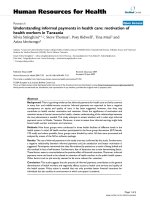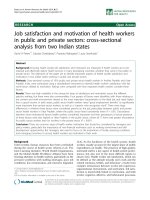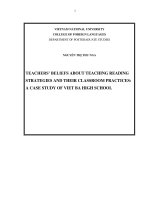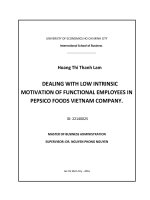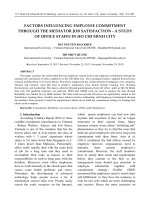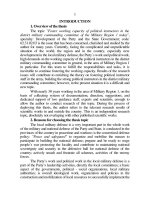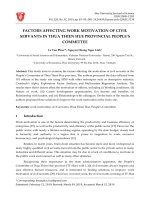WORKING MOTIVATION OF BACK-OFFICE STAFFS IN PETROLIMEX AVIATION FUEL JSC
Bạn đang xem bản rút gọn của tài liệu. Xem và tải ngay bản đầy đủ của tài liệu tại đây (1.5 MB, 132 trang )
NATIONAL ECONOMICS UNIVERSITY
BUSINESS SCHOOL
DAO DUY KHANH
WORKING MOTIVATION OF BACK-OFFICE
STAFFS IN PETROLIMEX AVIATION FUEL
JSC
MASTER OF BUSINESS ADMINISTRATION THESIS
HANOI – 2021
NATIONAL ECONOMICS UNIVERSITY
BUSINESS SCHOOL
DAO DUY KHANH
WORKING MOTIVATION OF BACK-OFFICE
STAFFS IN PETROLIMEX AVIATION FUEL
JSC
MASTER OF BUSINESS ADMINISTRATION THESIS
Supervisor: Dr. Tran Thi Van Hoa
HANOI – 2021
ACKNOWLEDGMENT
First of all, I am deeply grateful to the Business School, National Economics
University (BSNEU) with all the members, lecturers and assistants for the
knowledge and experience that has been shared through many lectures, discussions
and exams during EMBA program.
Next, I would like to express my deep and sincere gratitude to my supervisor,
Professor Tran Thi Van Hoa, National Economics University. Her wide knowledge
and logical way of thinking has been of great value to me. She gave me much
encouragement and many personal instructions which helped me a lot in doing this
thesis and provided me with a good basis for the presence of the thesis.
During this work, I collaborated with many people from Petrolimex Aviation
Fuel Joint Stock Company (Petrolimex Aviation), who gave me kind support in data
collection and contact making. I would like to send my special thanks to the ones
who helped me a lot in collecting data and information from Petrolimex Aviation.
I owe my loving thanks to my beloved family, without their encouragement,
support and understanding, it would be impossible for me to finish this work.
Hanoi, October 2021
Dao Duy Khanh
TABLE OF CONTENTS
ABBREVIATIONS
LIST OF TABLES
LIST OF FIGURES
EXECUTIVE SUMMARY
CHAPTER 1: INTRODUCTION..........................................................................1
1.1. Rationale..........................................................................................................1
1.2. Research objectives..........................................................................................2
1.3. Research questions...........................................................................................2
1.4. Research methodology.....................................................................................3
1.4.1. Research process.........................................................................................3
1.4.2. Data collection method................................................................................3
1.4.3. Data analysis...............................................................................................5
1.5. Research scope.................................................................................................5
1.6. Research structure............................................................................................5
CHAPTER
2:
THEORETICAL
BACKGROUND
ON
MOTIVATING
EMPLOYEE............................................................................................................6
2.1. Motivation and staff motivation.......................................................................6
2.1.1. Defining motivation....................................................................................6
2.1.2. Staff motivation...........................................................................................7
2.2. Motivation theories...........................................................................................7
2.2.1. Maslow’s hierarchy of needs theory............................................................7
2.2.2. Herzberg’s two-factor theory of motivation...............................................11
2.2.3. Adam’s Equity Theory of Motivation........................................................17
2.3. Research model and measurement scales for motivating employees..............21
2.3.1. Previous studies on motivating employees................................................21
2.3.2. Two-factor theory as research model.........................................................24
2.3.3. Measurement scales for motivating employees.........................................25
CHAPTER 3: ANALYZE CURRENT BACK-OFFICE STAFF MOTIVATION
AT PETROLIMEX AVIATION...........................................................................30
3.1. Overview of Petrolimex Aviation...................................................................30
3.1.1. General introduction..................................................................................30
3.1.2. Organizational structure............................................................................31
3.1.3. Main competitor of Petrolimex Aviation...................................................32
3.2. Analyzing back-office staff motivation at Petrolimex Aviation......................32
3.2.1. Respondents’ profile..................................................................................32
3.2.2. Hygiene factors.........................................................................................35
3.2.3. Motivation factors.....................................................................................59
3.3. Summary of findings......................................................................................73
3.3.1. Factors motivating employees...................................................................73
3.3.2. Factors demotivating employees...............................................................74
3.3.3. Reasons for factors demotivating employees demotivating employees.....75
CHAPTER 4: RECOMMENDATIONS TO ENHANCE BACK-OFFICE
STAFF MOTIVATION AT PETROLIMEX AVIATION....................................77
4.1. Petrolimex Aviation’s orientation for human resources management.............77
4.2. Recommendations for Petrolimex Aviation....................................................77
4.2.1. Establishing a back-office staff feedback system......................................77
4.2.2. Improving the performance appraisal system............................................80
4.2.3. Creating more interesting and challenging work.......................................82
4.2.4. Diversifying the labor resources in recruitment.........................................84
4.2.5. Making a more effective reward and recognition......................................85
4.2.6. Improving working conditions in Petrolimex Aviation..............................86
4.3. Recommendations for other stakeholders.......................................................87
4.3.1. Recommendations for employees..............................................................87
4.3.2. Recommendations for the State.................................................................87
CONCLUSION......................................................................................................89
LIST OF REFERENCES......................................................................................91
APENDIX 1: BACK-OFFICE STAFF MOTIVATION QUESTIONNAIRE. . .93
APENDIX 2: QUESTIONNAIRE’S RESULTS ON BACK-OFFICE STAFFS’
DEMOGRAPHIC INFORMATION....................................................................99
APPENDIX
3:
QUESTIONNAIRE’S
RESULTS
ON
PETROLIMEX
AVIATION BACK-OFFICE STAFFS’ MOTIVATIONAL STATUS..................0
ABBREVIATIONS
BSNEU
CIT
EMBA
HR
HRD
JD
LPG
PA
Petrolimex Aviation
US$
Vinapco
VND
Business School, National Economics University
Critical Incident Technique
English Master for Business Administration
Human Resources
Human Resources Department
Job Description
Liquefied Petroleum Gas
Performance Appraisal
Petrolimex Aviation Fuel Joint Stock Company
United States Dollar
Vietnam Air Petrol Company
Vietnam Dong
LIST OF TABLES
Table 1.1: In-depth interview.....................................................................................4
Table 2.1: Attributes to measure staff motivation....................................................25
Table 3.1: Petrolimex Aviation back-office staff qualification.................................35
Table 3.2: Petrolimex Aviation back-office staff satisfaction with working
conditions................................................................................................................35
Table 3.3: Petrolimex Aviation back-office staff satisfaction with current salary....41
Table 3.4: Petrolimex Aviation back-office staff satisfaction with payment policy. 43
Table 3.5: Petrolimex Aviation back-office staff satisfaction with salary increasing
policy....................................................................................................................... 46
Table 3.6: Petrolimex Aviation back-office staff satisfaction with current welfare..47
Table 3.7: Petrolimex Aviation back-office staff satisfaction with quality of
supervision..............................................................................................................51
Table 3.8: Petrolimex Aviation back-office staff satisfaction with company policy
and administration...................................................................................................53
Table 3.9: Petrolimex Aviation back-office staff satisfaction with interpersonal
relations................................................................................................................... 57
Table 3.10: Petrolimex Aviation back-office staff satisfaction with achievement and
recognition............................................................................................................... 60
Table 3.11: Awarding expenditure...........................................................................61
Table 3.12: Petrolimex Aviation back-office staff satisfaction with responsibility &
work itself................................................................................................................ 65
Table 3.13: Petrolimex Aviation back-office staff satisfaction with advancement...68
Table 3.14: Petrolimex Aviation back-office staff satisfaction with career training &
development............................................................................................................70
LIST OF FIGURE
Figure 1.1: Research process.....................................................................................3
Figure 2.1: Maslow’s hierarchy of needs...................................................................8
Figure 2.2: Herzberg’s scenarios of staff motivation...............................................16
Figure 2.3: Adam’s equity theory of motivation......................................................18
Figure 2.4: Research model.....................................................................................25
Figure 3.1: Organizational structure of Petrolimex Aviation...................................31
Figure 3.2: Petrolimex Aviation back-office staff age..............................................33
Figure 3.3: Petrolimex Aviation back-office staff gender........................................34
Figure 3.4: Average score for back-office staff satisfaction with working conditions
................................................................................................................................. 37
Figure 3.5: Average score of back-office staff satisfaction with current salary........41
Figure 3.6: Average score of back-office staff satisfaction with payment policy.....43
Figure 3.7: Current average score of back-office staff satisfaction with salary
increasing policy......................................................................................................46
Figure 3.8: Average score of back-office staff satisfaction with welfare and benefit
................................................................................................................................. 49
Figure 3.9: Supervisor fairness and unfairness in back-office staff treatment.........52
Figure 3.10: Average score of current back-office staff satisfaction with company
policy and administration........................................................................................53
Figure 3.11: Back-office staff satisfaction level on clear delegation........................66
Figure 3.12: Back-office staff satisfaction over trainee choosing............................71
Figure 3.13: Back-office staff satisfaction over time duration.................................72
Figure 3.14: Back-office staff satisfaction over effectiveness of training courses...72
EXECUTIVE SUMMARY
Petrolimex Aviation now is a leading corporation in the field of gas and oil
provided in the aviation industry in Vietnam within many years of establishment
and operation. However, back-office staff motivation in Petrolimex Aviation is not
good that leads to high turn-over rate and lowly committed back-office staffs.
Therefore, the objectives of this thesis were:
Identify the factors affecting back-office staff motivation at Petrolimex
Aviation Fuel Joint Stock Company;
Analyze the factors affecting back-office staff motivation at Petrolimex
Aviation Fuel Joint Stock Company following the two-factor model by Herzberg et
al. (1959);
Propose some solutions to enhance back-office staff motivation at
Petrolimex Aviation Fuel Joint Stock Company and make suggestions to
stakeholders.
Based on the survey results of 131 back-office staffs at Petrolimex Aviation
and in-depth interviews with 2 ex-back-office staffs and 3 current back-office staffs,
the thesis found that in generally, back-office staff motivation in Petrolimex
Aviation is not rather good, some hygiene factors are not ensured. The salary is not
effective in the current amount of salary, salary increasing policy, payment policy.
The working space is too small, sometimes too moisture and breathless. Welfare and
other benefits policy are not quite good. Many back-office staffs do not satisfy
really with those policies. Moreover, there is also ineffective recruitment; weak
interpersonal relationships among departments and between manager and backoffice staff. Some motivation factors are not good in practice: the performance
appraisal (PA) |s rather bad; because of weak PA, ineffectiveness in reward, bad
recognition. The bias of supervisor makes unequal recognition. The work is not
really interesting and challenging because of its inflexibility There are only few
promotion opportunities for Petrolimex Aviation back-office staff.
Besides that, some other motivation factors are really good in motivating
back-office staff. A good training policy that can satisfy the back-office staff
professional improvement need. Each back-office staff has a 2.4 million VND
annual training budget. A clear delegation with specific job description helps backoffice staff having enough authority and takes responsibility to do their works. A
clear and fair labor contract, a stable basic salary, social and health insurance
provides back-office staff a stable life, satisfy their biological needs and safety
needs. Moreover, other good hygiene factors help Petrolimex Aviation to reduce the
dissatisfaction level of back-office staff: pretty good working conditions are
convenient for back-office staffs to do their work. The functional organizational
structure is suitable, convenient, supportive for back-office staffs working.
Organization culture activities help back-office staff reduce stress, improve backoffice staff relationships.
This thesis recommended some solutions for Petrolimex Aviation to enhance
back-office staff motivation. The first is establishing a back-office staff feedback
system. This is the priority solution because one of the most important factors
leading to back-office staff demotivation in Petrolimex Aviation is lacking backoffice staff feedback. An effective feedback system demonstrates back-office staffs’
commitment, fosters trust between management and back-office staff, and
recognizes the values of back-office staffs to the success of the organization. It will
reduce the bias, bureaucracy, and corruption of supervisor. The second is improving
the performance appraisal to improve the fairness of achievement, recognition,
promotion, reward and training opportunity. The third is creating more interesting
and challenging work to increase back-office staff motivation. The fourth is
diversifying the labor resources in recruitment to have a more effective organization
policy, thus improving back-office staff motivation. The fifth is making a more
effective reward and recognition. The final is improving working conditions.
Moreover, there are also some recommendations for employees themselves and the
State as well.
1
CHAPTER 1
INTRODUCTION
1.1. Rationale
In the contemporary world, one of the most desirable objective of the
enterprise is profit and customer satisfaction. To fulfiil this goal, enterprenue invest
in their employees regarding attributes and skills. Employees are consider not only
an input to the enterprise’s production, but also the output to gain a turnover in the
future. Employees are motivated not only by money but also by their behavior and
attitude. Therefore, employees’ attitude is the decisive factors building up the
business productivity. Moreover, the relationship between the needs of motivation
and productivity. Motivation is an aspect that is approached by different work
levels, from senior to junior levels, employee to employer and self-employed.
Howver, we hardly can deny the manager role in boosting motivation process and
adding materials including traing, entertainment, rewards to motivates staffs. This
process should be as a strategy to achieve business productivity. Motivation is the
partten to connect employees to tasks and achie the business goal through rewards.
Petrolimex Aviation Fuel Joint Stock Company (Petrolimex Aviation) was
registered first time by Hanoi Department of Planning and Investment in April 28,
2008. Petrolimex Aviation officially became the second aviation fuel supplier in
Vietnam dealing with 2 strategic partnerships: Vietjet Air and Bamboo Airline. This
was a milestone in strategies to open petroleum market in order to improve quality
of ground services and jet fuel supply ensuring fair competition in the domestic fuel
aviation business. Petrolimex Aviation has been well recognized by its customers in
terms of service quality, price competitiveness, quick and appropriate response to
the customers’ requirements at Tan Son Nhat, Da Nang, Noi Bai, Cam Ranh, Cat Bi
international airports. The recognition has been encouraging Petrolimex Aviation to
overcome many difficulties and stably develop. Petrolimex Aviations’ main
operation is purchasing and selling fuel, which is called a retail business. Therefore,
one of the most significant factors contributing to the organization’s effecienct is
2
financial staffs. This business units oversee the financial transactions of a company
includes developing budgets, monitoring transactions, preparing financial reports,
examining the reports’ balance. In the fiercely competitive market, financial
department is the back-bone of business. Consequently, Petrolimex Aviations
always focuses on financial activities which always play an important role in retail
business because they take the most contribution to firms’health and transparency.
Petrolimex Aviations has implemented various soft-skill training courses, teambuiliding activities and orientation workshop to boost employees’ motivation and
their commiment. While the actual result to show the persist limitation.
With reasons mentioned above, the researcher has chosen the topic:
‘Motivating Back-Office staff at Petrolimex Aviation Fuel Joint Stock Company’
to accomplish the goal of examnizing staff motivation ladder and provide an useful
materials for supervisors to establish an effective strategy.
1.2. Research objectives
The primary aim of this study is to understand the factors affecting backoffice staff motivation at Petrolimex Aviation Fuel Joint Stock Company and then
finding out some solutions to improve such motivation. In order to do so, the
following objectives should be achieved:
Identify the factors affecting back-office staff motivation at Petrolimex
Aviation Fuel Joint Stock Company;
Analyze the factors affecting back-office staff motivation at Petrolimex
Aviation Fuel Joint Stock Company following the two-factor model by Herzberg et
al. (1959);
Propose some solutions to enhance back-office staff motivation at
Petrolimex Aviation Fuel Joint Stock Company and make suggestions to
stakeholders.
1.3. Research questions
In order to achieve the research objective, the researcher have to answer and
analyze these following questions:
3
What are the factors affecting back-office staff motivation at Petrolimex
Aviation Fuel Joint Stock Company?
How do the factors affect back-office staff motivation at Petrolimex
Aviation Fuel Joint Stock Company following the two-factor model by Herzberg et
al. (1959)?
What should Petrolimex Aviation do to improve its back-office staff
motivation?
1.4. Research methodology
1.4.1. Research process
The research was conducted as follows:
LITERATURE
REVIEW
FACTORS AFFECTING
MOTIVATION
THEORETICAL
BACKGROUND
IN-DEPTH
INTERVIEW
SOLUTIONS
ANALYZING THOSE
FACTORS’ IMPACT ON
MOTIVATION
SURVEY
Figure 1.1: Research process
Source: Researcher (2021)
1.4.2. Data collection method
Two sources of data collection were used:
1.4.2.1. Secondary data
Secondary data were collected from the previous studies, textbook, published
document, internets, etc. Besides that, reports and internal documents of Petrolimex
Aviation from 2010 – 2020 were used.
4
1.4.2.2. Primary data
Primary data were collected by in-depth interview and surveyed
questionnaire.
* In-depth interview
Table 1.1: In-depth interview
In-depth interviewee
Number
Ex back-office staffs of
Petrolimex Aviation
Current back-office staffs
of Petrolimex Aviation
2
Information collected
Ex back-office staffs’ assessment about
working conditions, salary and benefit,
reward and recognition, etc. at Petrolimex
Aviation
Opinions about HR policies and methods
3
to improve motivation for back-office
staffs in the corporation
Source: Researcher (2021)
* Surveyed questionnaire
- Respondents: Current back-office staffs of Petrolimex Aviation
- Sample size: The survey was sent to 131 back-office staffs at Petrolimex
Aviation.
- Sampling method: Convenient sampling method. A convenience sample is a
type of non-probability sampling method where the sample is taken from a group of
people easy to contact or to reach. This type of sampling is also known as grab
sampling or availability sampling. There are no other criteria to the sampling
method except that people be available and willing to participate. In addition, this
type of sampling method does not require that a simple random sample is generated,
since the only criterion is whether the participants agree to participate.
- Questionnaire design: The survey consists of two parts. Part A includes
information such as gender, age, qualification. Part B contains five-point Likerttype scale items: Strongly Disagree = 1, Disagree = 2, Neutral = 3, Agree = 4, and
Strongly Agree = 5. Respondents were asked to indicate and rate their perceptions
5
about the role of employability skills training programs. The number of valid
questionnaires used in research are 100. The exact and detailed results are presented
in Appendix 3.
1.4.3. Data analysis
Descriptive statistics (means) was used to determine the relative rankings of
motivation. The researcher used Microsoft Excel software to process the data.
1.5. Research scope
- Research object: This thesis focuses on analyzing factors affecting backoffice staff motivation at Petrolimex Aviation – Hanoi Branch following the twofactor model by Herzberg et al. (1959).
- Geographical space: Research was conducted at Petrolimex Aviation –
Hanoi Branch.
- Data collection time:
Primary data: 2021
Secondary data: from 2010 to 2020
1.6. Research structure
Apart from acknowledgement, table of contents, abbreviations, list of tables,
list of figures executive summary, conclusion, list of references and appendixes, the
main body of the thesis is divided into 4 chapters:
Chapter 1: Introduction
Chapter 2: Theoretical background on motivating employee
Chapter 3: Analyze current back-office staff motivation at Petrolimex
Aviation
Chapter 4: Recommendations to enhance back-office staff motivation at
Petrolimex Aviation
6
CHAPTER 2
THEORETICAL BACKGROUND ON MOTIVATING
EMPLOYEE
2.1. Motivation and staff motivation
Motivation has been studied for decades by scientists trying to understand
what makes people tick, why do they do the things they do, and what rewards get
results. Theories of motivation have been discussed, challenged, refuted, and
improved upon, in order to truly understand the human condition (Bessell, Dicks,
Wysocki, & Kepner, 2002; Locke & Latham, 1990). No one theory has proven to be
better than all others, however, the pool of knowledge on what motivates staffs
keeps expanding, laying down a stronger foundation for the next theory on work
motivation (Kohn, 1987). Nelson (1999) wrote, ‘staff motivation may represent one
of the last frontiers for organizational leverage’ (p.265). This being the case, it is
important that managers, supervisors, and organizations understand what exactly
motivates their staffs to perform better to get the most from them. By tapping into
the potential motivation each staff possesses, organizations can increase their
outputs, innovations, and become leaders in their industries instead of just merely
surviving.
2.1.1. Defining motivation
Motivation is the way to make people to behave in certain ways to gain
desired goals or objectives (Sargent, 1990). In the last few years, motivation is
considered as an essential tool that helps managers or supervisors to inspire staffs to
work more productive. Besides, according to Francesco and Gold (1998),
motivation is defined as the amount of effort to encourage someone to do something
more effectively or motivation is the effort to satisfy individual needs to accomplish
the organization goals (Robbins, 1996).
7
Kanfer (1990) note that work motivation is the processes to connect staffs to
the organization with the psychological mechanism and attract constant, thus, the
effort and energy to accomplish jobs is essential.
2.1.2. Staff motivation
Wiley (1997) suggests that ensuring the success of a company, employers
must understand what motivates their staffs, and such understanding is essential to
improving productivity. These suggestions imply that organizational success
depends heavily on staff motivation, and managers must understand what motivates
their staffs in order to motivate their staffs. Understanding the concept of motivation
could assist incompetent and inexperienced managers, in terms of staff motivation,
identify what motivates their staffs.
2.2. Motivation theories
2.2.1. Maslow’s hierarchy of needs theory
One of the most popular theory relates to motivation is Maslow’s Hierarchy
of Needs theory. Maslow’s Hierarchy of Needs is a theory in psychology, proposed
by Abraham Maslow in his 1943 paper A Theory of Human motivation. The main
content of this theory is to study about some basic needs of human being such as:
physiological, safety, love – belonging, esteem and self – actualization.
In order to understand clearly about Maslow’s Hierarchy of needs, we can
see it portraying in the shape of pyramid, with the largest and lowest levers of needs
that symbol for physiological which is always at the bottom, and the need for selfactualization at the top. The needs in middle are one by one stand for safety needs,
belonging needs and esteem needs.
8
Figure 2.1: Maslow’s hierarchy of needs
Source: Dinamehta (2013)
Physiological needs: Physiological needs are obvious – they are literal
requirements for human survival. If these requirements are not supported, (with the
exception of clothing and shelter) the human body cannot continue to function.
Physiological needs include breathing, food, water, sexual activity, shelter… Air,
water and food are metabolic requirements for survival in all animals, including
humans. The intensity of the human sexual instinct is shaped more by sexual
competition than maintaining a birth rate adequate to survival of the species.
Safety needs: With their physical needs relatively satisfied, the individual’s
safety needs take precedence and dominate behavior. These needs have to do with
people’s desire for a predictable, orderly world in which injustice and inconsistency
are under control. In the world of work, this safety needs manifest themselves in
such things as a preference for job security, grievance procedures for protecting the
individual from unilateral authority, savings accounts, insurance policies, and the
like. For most of human history many individuals have found their safety needs
9
unmet, although the poor – both those who are poor as a class and those who are
temporarily poor (university students would be an example)-must often still address
these needs. Safety and Security needs include personal security, financial security,
health and well-being, safety against accidents/illness and their adverse impacts.
Love and Belonging needs: After physiological and safety needs are
fulfilled, the third layer of human needs is social and involves emotionally based
relationships in general, such as friendship, co-operates (partners), family. Humans
demand to feel a sense of belonging and acceptance, whether it comes from a large
social group, such a clubs, office culture, religious groups, professional
organizations, sports teams, or small social connections (family members, intimate
partners, mentors, close colleagues, confidants). They need to love and be loved by
others. In the absence of these elements, many people become susceptible to
loneliness, social anxiety, and clinical depression.
Esteem needs: All humans have a need to be respected and to have selfesteem and self-respect. Also known as the belonging need, esteem presents the
normal human desire to be accepted and valued by others. People need to engage
themselves to gain recognition and have an activity or activities that give the person
a sense of contribution, to feel accepted and self-valued, be it in a profession or
hobby. Imbalances at this level can result in low self-esteem or an inferiority
complex. People with low self-esteem need respect from others. They may seek
fame, which again depends on others. However, that many people with low selfesteem will not be able to improve their view of themselves simply by receiving
fame, respect, and glory externally, but must first accept them internally.
Psychological imbalances such as depression can also prevent one from obtaining
self-esteem on both levels. Most people have a need for a stable self-respect and
self-esteem. Maslow noted two versions of esteem needs, a lower one and a higher
one. The lower is the need for the respect of others, the need for status, recognition,
fame, prestige and attention. The higher one is the need for self-respect, the need for
strength, competence, mastery, self-confidence, independence and freedom. The
10
latter one ranks higher because it rests more on inner competence won through
experience. Deprivation of these needs can lead to an inferiority complex, weakness
and helplessness. Maslow stresses the dangers associated with self-esteem based on
fame and outer recognition instead of inner competence. He sees healthy selfrespect as based on earned respect.
Self-actualization: ‘What a man can be, he must be’. This saying forms the
basis of the perceived need for self-actualization. This level of needs pertains to
what a person’s full potential. Maslow describes this desire as desire to become
more and more what one is, to become everything that one is capable of becoming.
This is a broad definition of the need for self-actualization, but when applied to
individual the need is specific. For example, one individual may have the strong
desire to become an ideal parent in another it may be expressed athletically, and in
another it may be expressed in painting, pictures or invention. As mentioned before,
in order to reach a clear understanding of this level of need one must first not only
achieve the previous needs, physiological, safety, love and esteem, but also master
these needs.
Apply this theory in human resource management:
(i) Physiological needs: Provide lunch breaks, rest breaks, and wages that
are sufficient to purchase the essential of life.
(ii) Safety needs: Provide a safe working environment, retirement benefits,
and job security.
(iii) Love and belonging needs: Create a sense of community via teambased projects and social events.
(iv) Esteem needs: Recognize achievements to make staffs feel appreciated
and valued.
(v) Self-actualization: Provide staffs a challenge and the opportunity to reach
their full career potential.
However, not all people are driven by the same needs – at any time different
people may be motivated by entirely different factors. For example, an artist may
11
even suffer from physiological shortage, he still has desire to fulfill his needs of
esteem, knowledge and aesthetics. Thus, it is important to understand the needs
being pursued by each staff. To motivate a staff, the manager must be able to
recognize the needs level at which the staff is operating, and use those needs as
levels of motivation.
2.2.2. Herzberg’s two-factor theory of motivation
Two-factor Theory also known as Herzberg’s Motivation Theory, Herzberg’s
Motivation-Hygiene theory, Motivation-Hygiene Theory and The Dual-Factor
Theory. This theory was developed in 1959 by Professor Frederick Irving Herzberg.
According to Herzberg, there are certain factors in the workplace that result
in job satisfaction while other job factors that prevent dissatisfaction. He proposed
that the opposite of ‘Satisfaction’ is not dissatisfaction but ‘No satisfaction’ and the
opposite of ‘Dissatisfaction’ is not satisfaction but ‘No Dissatisfaction’.
Herzberg’s motivation theory emerged from a collection of data
gathered by the interview of 203 accountants and engineers within the
Pittsburgh area, chosen because of their professions’ growing importance in
the business world. The interview process consisted of asking the respondents
to describe a work situation where they felt very happy as well as very
unhappy. These descriptions were to include as many details as possible,
including their feelings, the interpretation of the situation as well as the events
that are suggestive of a change.
In 1968, Herzberg stated that his two-factor theory study had already been
replicated 16 times in a wide variety of populations including some in Communist
countries, and corroborated with studies using different procedures that agreed with
his original findings regarding intrinsic staff motivation making it one of the most
widely replicated studies on job attitudes.
While the Motivator-Hygiene concept is still well regarded, satisfaction and
dissatisfaction are generally no longer considered to exist on separate scales. The
separation of satisfaction and dissatisfaction has been shown to be an artifact of the
12
Critical Incident Technique (CIT) used by Herzberg to record events. Furthermore,
it has been noted the theory does not allow for individual differences, such as
particular personality traits, which would affect individuals’ unique responses to
motivating or hygiene factors.
A number of behavioral scientists have pointed to inadequacies in the need
hierarchy and motivation-hygiene theories. The most basic is the criticism that both
of these theories contain the relatively explicit assumption that happy and satisfied
workers produce more, even though this might not be the case. For example, if
playing a better game of golf is the means chosen to satisfy one’s need for
recognition, then one will find ways to play and think about golf more often,
perhaps resulting in an accompanying lower output on the job. Another problem is
that these and other statistical theories are concerned with explaining ‘average’
behavior, despite considerable differences between individuals that may affect one’s
motivational factors. For instance, in their pursuit of status a person might take a
balanced view and strive to pursue several behavioral paths in an effort to achieve a
combination of personal status objectives.
In other words, an individual’s expectation or estimated probability that a
given behavior will bring a valued outcome determines their choice of means and
the effort they will devote to these means. In effect, this diagram of expectancy
depicts a staff asking themselves the question posed by one investigator, ‘How
much payoff is there for me toward attaining a personal goal while expending so
much effort toward the achievement of an assigned organizational objective?’
The analysis of the responses confirmed the proposed hypothesis, where
some factors where contributors to job satisfaction, while others were not. In
addition, some factors were noted to be a source of dissatisfaction when absent.
These were categorized as ‘Motivation’ and ‘Hygiene’ factors, the latter also being
referred to as Maintenance Factors.
13
Hygiene factors:
Hygiene Factors include Working Conditions, Salary, Company Policy &
Administration, Quality of Supervision, and Interpersonal Relations.

